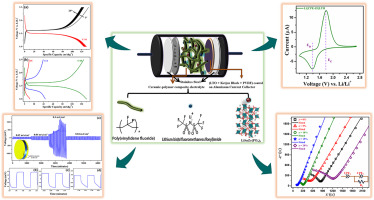当前位置:
X-MOL 学术
›
J. Alloys Compd.
›
论文详情
Our official English website, www.x-mol.net, welcomes your feedback! (Note: you will need to create a separate account there.)
Effect of NASICON-type LiSnZr(PO4)3 ceramic filler on the ionic conductivity and electrochemical behavior of PVDF based composite electrolyte
Journal of Alloys and Compounds ( IF 6.2 ) Pub Date : 2020-05-01 , DOI: 10.1016/j.jallcom.2020.153991 Tanvi Pareek , Sushmita Dwivedi , Shadab Ali Ahmad , Manish Badole , Sunil Kumar
Journal of Alloys and Compounds ( IF 6.2 ) Pub Date : 2020-05-01 , DOI: 10.1016/j.jallcom.2020.153991 Tanvi Pareek , Sushmita Dwivedi , Shadab Ali Ahmad , Manish Badole , Sunil Kumar

|
Abstract Replacement of liquid electrolytes with polymer-based solid electrolytes is considered as the key to the realization of high-energy lithium metal anode in rechargeable batteries. However, the polymer electrolytes suffer from poor lithium-ion conductivity and low lithium-ion transference number. Poly(vinylidene difluoride) (PVDF) based polymer-ceramic composite electrolytes were fabricated at room temperature via the solution casting method. The effect of NASICON-type lithium tin zirconium phosphate (LiSnZr(PO4)3) particles added as the ceramic filler to the PVDF + LiTFSI polymer-salt matrix on the structure, ionic conductivity, transference number, and electrochemical behaviour was studied. The x-ray diffraction (XRD) and fourier transform infrared (FTIR) absorption studies confirmed the structure of the fabricated polymer as the mixed (α+β) phases of PVDF. The addition of LiSnZr(PO4)3 ceramic filler resulted in the enhancement in Li+ conductivity of the polymer composite and the sample with 15 wt% ceramic filler (CPE-15) showed the highest lithium-ion conductivity of 5.76 × 10−5 Scm−1 at 300 K. The addition of 15 wt% LSZP improved the stability window up to 4.73 V as confirmed by linear sweep voltammetry (LSV). A significant improvement in (tLi+) resulted from the addition of ceramic filler. The reversibility of Li+ transport across the composite ceramic-polymer electrolyte (15 wt% CPE) was confirmed by galvanostatic charging-discharging of symmetric lithium (Li||CPE||Li) cell at various current density for 100 h. Li||CPE||LTO cells with Li4Ti5O15 (LTO) as the working electrode, CPE-15 as the Li+ conducting separator, and Li foil as the counter electrode were fabricated to demonstrate the application of the CPE-15 as the electrolyte in all-solid-state batteries. Li||CPE||LTO cell delivered a specific discharge capacity of 133 mAhg−1 and 88% capacity retention after 20 cycles at 0.1C rate.
中文翻译:

NASICON型LiSnZr(PO4)3陶瓷填料对PVDF基复合电解质离子电导率和电化学行为的影响
摘要 用聚合物基固体电解质代替液体电解质被认为是实现可充电电池高能锂金属负极的关键。然而,聚合物电解质存在锂离子传导性差和锂离子转移数低的问题。通过溶液浇铸法在室温下制备了基于聚偏二氟乙烯 (PVDF) 的聚合物-陶瓷复合电解质。研究了作为陶瓷填料添加到 PVDF + LiTFSI 聚合物-盐基体中的 NASICON 型锂锡磷酸锆 (LiSnZr(PO4)3) 颗粒对结构、离子电导率、迁移数和电化学行为的影响。X 射线衍射 (XRD) 和傅立叶变换红外 (FTIR) 吸收研究证实了所制备聚合物的结构为 PVDF 的混合 (α+β) 相。LiSnZr(PO4)3 陶瓷填料的添加提高了聚合物复合材料的 Li+ 电导率,并且含有 15 wt% 陶瓷填料 (CPE-15) 的样品的锂离子电导率最高,为 5.76 × 10−5 Scm− 1 在 300 K。如线性扫描伏安法 (LSV) 所证实,添加 15 wt% LSZP 将稳定性窗口提高到 4.73 V。由于添加了陶瓷填料,(tLi+) 的显着改善。通过对称锂 (Li||CPE||Li) 电池在不同电流密度下的恒电流充放电 100 小时,证实了 Li+ 在复合陶瓷-聚合物电解质(15 wt% CPE)上传输的可逆性。Li||CPE||LTO 电池以 Li4Ti5O15 (LTO) 作为工作电极,CPE-15 作为 Li+ 导电隔膜,Li 箔作为对电极,以证明 CPE-15 作为电解质在所有电池中的应用- 固态电池。Li||CPE||LTO 电池在 0.1C 倍率下循环 20 次后提供 133 mAhg-1 的比放电容量和 88% 的容量保持率。
更新日期:2020-05-01
中文翻译:

NASICON型LiSnZr(PO4)3陶瓷填料对PVDF基复合电解质离子电导率和电化学行为的影响
摘要 用聚合物基固体电解质代替液体电解质被认为是实现可充电电池高能锂金属负极的关键。然而,聚合物电解质存在锂离子传导性差和锂离子转移数低的问题。通过溶液浇铸法在室温下制备了基于聚偏二氟乙烯 (PVDF) 的聚合物-陶瓷复合电解质。研究了作为陶瓷填料添加到 PVDF + LiTFSI 聚合物-盐基体中的 NASICON 型锂锡磷酸锆 (LiSnZr(PO4)3) 颗粒对结构、离子电导率、迁移数和电化学行为的影响。X 射线衍射 (XRD) 和傅立叶变换红外 (FTIR) 吸收研究证实了所制备聚合物的结构为 PVDF 的混合 (α+β) 相。LiSnZr(PO4)3 陶瓷填料的添加提高了聚合物复合材料的 Li+ 电导率,并且含有 15 wt% 陶瓷填料 (CPE-15) 的样品的锂离子电导率最高,为 5.76 × 10−5 Scm− 1 在 300 K。如线性扫描伏安法 (LSV) 所证实,添加 15 wt% LSZP 将稳定性窗口提高到 4.73 V。由于添加了陶瓷填料,(tLi+) 的显着改善。通过对称锂 (Li||CPE||Li) 电池在不同电流密度下的恒电流充放电 100 小时,证实了 Li+ 在复合陶瓷-聚合物电解质(15 wt% CPE)上传输的可逆性。Li||CPE||LTO 电池以 Li4Ti5O15 (LTO) 作为工作电极,CPE-15 作为 Li+ 导电隔膜,Li 箔作为对电极,以证明 CPE-15 作为电解质在所有电池中的应用- 固态电池。Li||CPE||LTO 电池在 0.1C 倍率下循环 20 次后提供 133 mAhg-1 的比放电容量和 88% 的容量保持率。



























 京公网安备 11010802027423号
京公网安备 11010802027423号